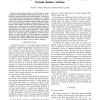Free Online Productivity Tools
i2Speak
i2Symbol
i2OCR
iTex2Img
iWeb2Print
iWeb2Shot
i2Type
iPdf2Split
iPdf2Merge
i2Bopomofo
i2Arabic
i2Style
i2Image
i2PDF
iLatex2Rtf
Sci2ools
CDC
2008
IEEE
2008
IEEE
Effective sensing regions and connectivity of agents undergoing periodic relative motions
— Time-varying graphs are widely used to model communication and sensing in multi-agent systems such as mobile sensor networks and dynamic animal groups. Connectivity is often determined by the presence of neighbors in a sensing region defined by relative position and/or bearing. We present a method for calculating the effective sensing region that defines the connectivity between agents undergoing periodic relative motions. This method replaces time-varying calculations with time-invariant calculations which greatly simplifies studies of connectivity and convergence of consensus algorithms. We apply the technique to the case of agents moving in a common fixed direction with sinusoidal speed oscillations and fixed relative phases. For agents moving in a straight line, we show analytically how to select dynamics for fast convergence of consensus. Further numerical results suggest graph-level connectivity may be achieved with a sensing radius lower than that predicted by percolati...
| Added | 29 May 2010 |
| Updated | 29 May 2010 |
| Type | Conference |
| Year | 2008 |
| Where | CDC |
| Authors | Daniel T. Swain, Ming Cao, Naomi Ehrich Leonard |
Comments (0)

